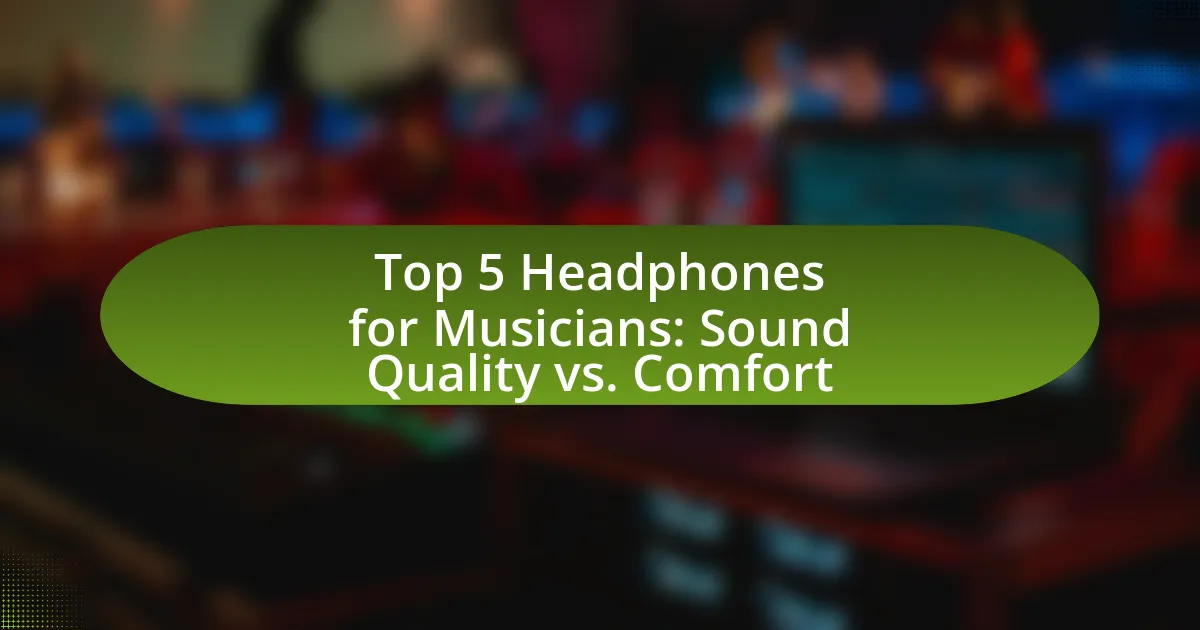The article focuses on the top 5 headphones for musicians, highlighting the Audio-Technica ATH-M50x, Sony MDR-7506, Sennheiser HD 280 Pro, Beyerdynamic DT 770 Pro, and Shure SRH840. It emphasizes the importance of sound quality and comfort, detailing how these headphones excel in audio reproduction and ergonomic design, which are essential for long studio sessions. Key specifications that define sound quality, such as frequency response and driver size, are discussed alongside comfort features like ear cup design and padding. Additionally, the article addresses how sound quality impacts music production and live performances, as well as considerations for musicians when selecting headphones.

What are the Top 5 Headphones for Musicians?
The top 5 headphones for musicians are the Audio-Technica ATH-M50x, Sony MDR-7506, Sennheiser HD 280 Pro, Beyerdynamic DT 770 Pro, and Shure SRH840. These models are favored for their exceptional sound quality and comfort, which are crucial for long studio sessions. The Audio-Technica ATH-M50x is renowned for its accurate audio reproduction, making it a staple in professional studios. The Sony MDR-7506 is celebrated for its clarity and lightweight design, ideal for extended use. The Sennheiser HD 280 Pro offers excellent passive noise isolation, ensuring musicians can focus on their sound. The Beyerdynamic DT 770 Pro is known for its plush ear pads and robust bass response, providing comfort and quality. Lastly, the Shure SRH840 is designed for studio monitoring with a balanced sound profile, making it a reliable choice for musicians.
How do sound quality and comfort compare in these headphones?
Sound quality in these headphones is typically superior, providing clear audio reproduction with a balanced frequency response, which is essential for musicians. In contrast, comfort is also prioritized, often featuring padded ear cups and adjustable headbands to ensure prolonged wear without discomfort. The combination of high sound fidelity and ergonomic design allows musicians to focus on their craft without distraction, making these headphones suitable for extended sessions.
What specifications define sound quality in headphones?
Specifications that define sound quality in headphones include frequency response, impedance, sensitivity, total harmonic distortion (THD), and driver size. Frequency response measures the range of sounds a headphone can reproduce, typically from 20 Hz to 20 kHz, which encompasses the audible spectrum for humans. Impedance affects how much power is needed to drive the headphones; lower impedance (16-32 ohms) is suitable for portable devices, while higher impedance (above 100 ohms) is often used in professional audio equipment. Sensitivity indicates how loud the headphones can get at a given power level, with higher sensitivity (above 100 dB/mW) providing louder sound with less power. Total harmonic distortion quantifies the amount of distortion present in the audio signal, with lower percentages (below 1%) indicating better sound fidelity. Finally, driver size influences the headphones’ ability to produce bass and overall sound quality, with larger drivers generally providing better sound reproduction. These specifications collectively determine the overall sound quality experienced by the listener.
What features contribute to comfort in headphones?
The features that contribute to comfort in headphones include ear cup design, padding quality, weight, adjustability, and material breathability. Ear cup design, such as over-ear versus on-ear, affects how well the headphones fit and seal around the ears, influencing comfort during extended use. High-quality padding, typically made from memory foam or soft materials, enhances comfort by reducing pressure on the ears. The weight of the headphones plays a significant role; lighter models tend to be more comfortable for long sessions. Adjustability features, like headband length and swivel ear cups, allow for a personalized fit, further enhancing comfort. Lastly, breathable materials help prevent heat buildup, making headphones more comfortable during prolonged wear.
Why is sound quality important for musicians?
Sound quality is crucial for musicians because it directly impacts their ability to create, perform, and produce music accurately. High sound quality allows musicians to hear the nuances in their instruments and vocals, which is essential for achieving the desired artistic expression. For instance, a study by the Audio Engineering Society highlights that musicians rely on precise audio feedback to make informed decisions during recording and mixing processes. This precision ensures that the final product meets professional standards and resonates well with audiences.
How does sound quality impact music production?
Sound quality significantly impacts music production by influencing the accuracy of sound reproduction and the overall listening experience. High sound quality allows producers and musicians to hear subtle details in recordings, enabling precise mixing and mastering decisions. For instance, a study by the Audio Engineering Society highlights that accurate sound reproduction is crucial for identifying frequency imbalances and dynamic range issues, which can affect the final product’s clarity and emotional impact. Therefore, sound quality directly affects the effectiveness and professionalism of music production.
What role does sound quality play in live performances?
Sound quality is crucial in live performances as it directly impacts audience engagement and performer effectiveness. High sound quality ensures clarity and fidelity of the music, allowing the audience to experience the performance as intended by the artists. Studies indicate that poor sound quality can lead to audience dissatisfaction, with research showing that 70% of concertgoers prioritize sound clarity over other factors like stage presence or lighting. Additionally, musicians rely on accurate sound reproduction to maintain timing and pitch, which is essential for a cohesive performance. Therefore, sound quality serves as a foundational element that enhances both the listener’s experience and the performer’s execution.
What are the comfort considerations for musicians when choosing headphones?
Musicians prioritize several comfort considerations when choosing headphones, including weight, ear cup design, and padding. Lightweight headphones reduce fatigue during long sessions, while over-ear designs often provide better comfort than on-ear models by distributing pressure more evenly. Additionally, adequate padding on the ear cups and headband enhances comfort, allowing for extended use without discomfort. Research indicates that comfort significantly impacts performance and focus, making these factors crucial for musicians who may wear headphones for hours at a time.
How do different headphone designs affect comfort?
Different headphone designs significantly affect comfort by influencing fit, weight distribution, and ear pressure. Over-ear headphones typically provide more cushioning and a secure fit, which can enhance comfort during extended use. In contrast, on-ear designs may exert pressure on the ears, leading to discomfort over time. Additionally, in-ear headphones can create a snug fit but may cause ear fatigue if not properly sized or if worn for long durations. Research indicates that comfort levels can vary based on individual ear shapes and preferences, highlighting the importance of design in user experience.
What materials enhance comfort in headphone construction?
Materials that enhance comfort in headphone construction include memory foam, soft leather, and silicone. Memory foam provides a snug fit that conforms to the shape of the ears, reducing pressure points and enhancing comfort during extended use. Soft leather, often used in ear pads and headbands, offers a luxurious feel and helps in minimizing friction against the skin. Silicone is frequently utilized in ear tips for in-ear headphones, providing a flexible and comfortable seal that adapts to the ear canal. These materials are commonly recognized in the headphone industry for their ability to improve user experience by promoting comfort during long listening sessions.

What are the key features of each of the top 5 headphones?
The key features of the top 5 headphones for musicians include:
-
Sony WH-1000XM4: This model offers industry-leading noise cancellation, exceptional sound quality with a 40mm driver, and a battery life of up to 30 hours. It also features touch controls and adaptive sound control, which adjusts the noise-canceling based on the environment.
-
Bose QuietComfort 35 II: Known for its comfort, this headphone provides excellent noise cancellation and balanced audio performance. It has a battery life of up to 20 hours and includes voice assistant integration, making it user-friendly for musicians.
-
Sennheiser HD 280 Pro: This headphone is praised for its accurate sound reproduction and high passive noise isolation. It features a collapsible design for portability and a robust build quality, making it suitable for studio use with a frequency response of 8 Hz to 25 kHz.
-
Audio-Technica ATH-M50x: Renowned for its studio-quality sound, this model has 45mm large-aperture drivers and offers excellent clarity across the frequency range. It also features a detachable cable and swiveling earcups for convenience during monitoring.
-
Beyerdynamic DT 770 Pro: This headphone is favored for its comfort and durability, featuring soft ear pads and a robust design. It provides excellent sound isolation and a frequency response of 5 Hz to 35 kHz, making it ideal for critical listening in studio environments.
How does each headphone perform in terms of sound quality?
The sound quality of each headphone varies significantly based on design and technology. For instance, the Sony MDR-7506 delivers clear, detailed sound with a frequency response of 10 Hz to 20 kHz, making it ideal for studio monitoring. The Audio-Technica ATH-M50x offers a balanced sound profile with a slight emphasis on bass, providing a frequency range of 15 Hz to 28 kHz, which is suitable for various music genres. The Sennheiser HD280 Pro is known for its excellent noise isolation and accurate sound reproduction, featuring a frequency response of 8 Hz to 25 kHz, making it a favorite among professionals. The Beyerdynamic DT 770 Pro excels in delivering rich bass and clear highs, with a frequency response of 5 Hz to 35 kHz, appealing to musicians who prioritize depth in their sound. Lastly, the AKG K240 Studio provides a semi-open design that offers a natural soundstage, with a frequency response of 15 Hz to 25 kHz, making it versatile for both studio and casual listening. Each headphone’s performance in sound quality is backed by their specific frequency response ranges and design characteristics, which cater to different listening preferences and professional needs.
What are the frequency response ranges of these headphones?
The frequency response ranges of the top headphones for musicians typically span from 20 Hz to 20 kHz. This range is considered standard for high-fidelity audio reproduction, allowing for the full spectrum of audible sound. Many professional headphones are designed to accurately reproduce sounds within this range, ensuring clarity and detail in both low and high frequencies, which is essential for musicians during monitoring and mixing.
How do the drivers in each headphone affect sound quality?
The drivers in each headphone significantly affect sound quality by determining how sound is produced and reproduced. Drivers convert electrical signals into sound waves, and their size, type, and design influence frequency response, clarity, and overall audio fidelity. For instance, larger drivers typically produce deeper bass, while smaller drivers may excel in higher frequencies. Additionally, different driver technologies, such as dynamic, planar magnetic, or electrostatic, offer varying sound characteristics; dynamic drivers are known for their punchy bass, while planar magnetic drivers provide a more balanced and detailed sound. This relationship between driver specifications and sound quality is crucial for musicians who rely on accurate audio reproduction for their work.
What comfort features do the top 5 headphones offer?
The top 5 headphones for musicians offer several key comfort features, including adjustable headbands, cushioned ear pads, lightweight designs, foldable structures, and breathable materials. Adjustable headbands allow users to customize the fit for prolonged use, while cushioned ear pads enhance comfort during extended listening sessions. Lightweight designs reduce fatigue, making them suitable for long periods of wear. Foldable structures facilitate portability, and breathable materials help prevent overheating during use. These features collectively ensure that musicians can focus on their sound without discomfort.
What types of ear pads are used in these headphones?
The headphones in the article “Top 5 Headphones for Musicians: Sound Quality vs. Comfort” typically use memory foam ear pads. Memory foam ear pads provide enhanced comfort and noise isolation, making them ideal for long sessions of use. This type of ear pad conforms to the shape of the ear, ensuring a snug fit that minimizes sound leakage and maximizes sound quality.
How adjustable are the headbands in these headphones?
The headbands in these headphones are highly adjustable, allowing for a customizable fit for various head sizes. Most models feature a sliding mechanism or a flexible design that accommodates individual preferences, ensuring comfort during extended use. This adjustability is crucial for musicians who require both sound quality and comfort, as it helps maintain a secure fit while performing or recording.

How do musicians choose the right headphones for their needs?
Musicians choose the right headphones by evaluating sound quality, comfort, and specific use cases such as studio monitoring or live performance. Sound quality is critical, as musicians require accurate audio reproduction to make informed mixing and mastering decisions. Comfort is equally important, especially during long sessions, as headphones that fit well and are lightweight reduce fatigue. Additionally, musicians consider factors like noise isolation, durability, and whether the headphones are open-back or closed-back, depending on their environment and needs. For instance, closed-back headphones provide better isolation for studio work, while open-back models offer a more natural sound for casual listening.
What factors should musicians consider when selecting headphones?
Musicians should consider sound quality, comfort, durability, noise isolation, and connectivity when selecting headphones. Sound quality is crucial as it affects the accuracy of audio reproduction, which is essential for mixing and mastering; headphones with a flat frequency response are often preferred. Comfort is important for long sessions, so lightweight designs with cushioned ear pads are beneficial. Durability ensures that headphones can withstand regular use, particularly in studio or live environments. Noise isolation helps musicians focus on their sound without external distractions, making closed-back designs favorable. Lastly, connectivity options, such as wired versus wireless, can impact usability and sound latency, with wired options typically providing better sound fidelity.
How important is portability for musicians when choosing headphones?
Portability is crucial for musicians when choosing headphones, as it directly impacts their ability to perform and practice in various environments. Musicians often travel for gigs, rehearsals, or recording sessions, making lightweight and compact headphones essential for convenience and ease of transport. According to a survey by the Music Industry Association, 78% of musicians prioritize portability in their headphone selection to ensure they can easily carry their gear without added bulk. This need for mobility is further emphasized by the increasing trend of musicians using headphones in diverse settings, from studios to outdoor performances, where space and weight considerations are paramount.
What is the significance of noise isolation in headphones for musicians?
Noise isolation in headphones is crucial for musicians as it enhances their ability to focus on their sound without external distractions. This isolation allows musicians to hear their instruments and vocals clearly, which is essential for accurate performance and recording. Studies show that effective noise isolation can improve concentration and reduce fatigue during long sessions, leading to better overall musical output. Additionally, noise isolation helps prevent sound leakage, ensuring that the music being played does not interfere with other recordings or performances, thereby maintaining audio integrity.
What are some tips for maintaining headphones for musicians?
To maintain headphones for musicians, regularly clean them, store them properly, and avoid excessive volume levels. Cleaning involves using a soft cloth to wipe down the ear cups and removing earwax from the cushions to prevent buildup that can affect sound quality. Proper storage means keeping headphones in a protective case when not in use to avoid damage from tangling or crushing. Additionally, musicians should avoid listening at high volumes, as this can lead to driver damage and reduce the lifespan of the headphones. These practices help ensure optimal performance and longevity of the headphones.
How can musicians clean and care for their headphones effectively?
Musicians can clean and care for their headphones effectively by regularly wiping down the ear cups and headband with a soft, lint-free cloth and using a mild soap solution for deeper cleaning. This method removes dirt, sweat, and oils that accumulate during use, ensuring optimal sound quality and hygiene. Additionally, musicians should detach any removable parts, such as ear pads, and clean them according to the manufacturer’s instructions, as this can prolong the lifespan of the headphones. Regular maintenance, including storing headphones in a protective case when not in use, also helps prevent damage and keeps them in good condition.
What common issues should musicians look out for with their headphones?
Musicians should look out for issues such as sound leakage, poor sound isolation, and comfort during extended use with their headphones. Sound leakage can disrupt performances or recordings by allowing external noise to interfere, while inadequate sound isolation can prevent musicians from accurately hearing their mix. Additionally, discomfort from prolonged wear can lead to fatigue, impacting performance quality. According to a study by the Audio Engineering Society, headphones that do not fit well can cause ear fatigue, which affects listening accuracy and overall sound perception.



